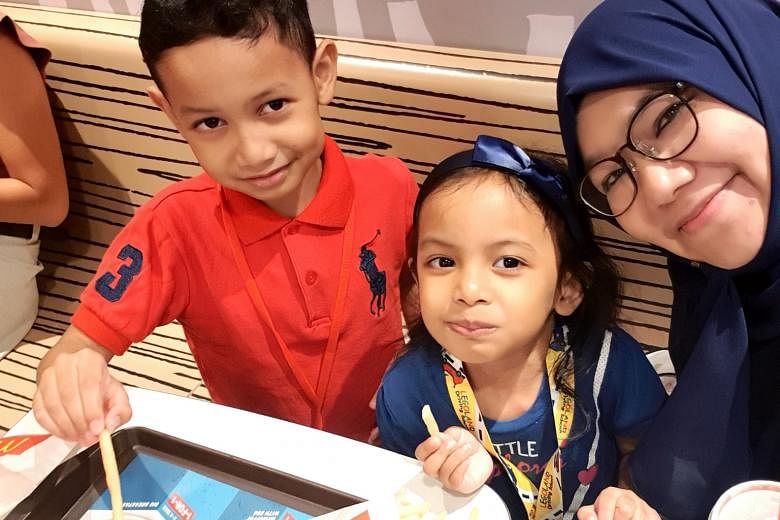Eleven years ago, she fought the H1N1 flu and survived after a near-death experience.
Ustazah Nadia Hanim never expected that she would have to battle another deadly disease - Covid-19.
The 36-year-old Singaporean religious teacher tested positive for the coronavirus on March 13, becoming the country's Case 203.
Ms Nadia recounted how she started feeling unwell on the evening of March 11, her daughter's fourth birthday, three days after returning from a work trip to Jakarta.
She was feverish, her head throbbed and her body ached.
The next day, her temperature rose to 39.2 deg C at one point, and she felt breathless.
That was when Ms Nadia, who has asthma, decided to seek treatment at Changi General Hospital (CGH).
On March 13, her swab test results for the virus returned positive.
"I felt numb, dumbfounded, lost for words," said the mother of two children aged four and eight.
"I wasn't panicking, but my mind was racing. I tried to recall those I have been in close contact with. My first thought was for my children and my husband."
It was an all-too-familiar experience for Ms Nadia, who was discharged from CGH on March 29 after being hospitalised for about three weeks.
ON THE BRINK OF DEATH
Back in 2009, she woke up from her sleep one night feeling breathless after having flu symptoms for a few days.
"I was thinking it was just a normal cold," said Ms Nadia, who dreamt that she was drowning.
"I woke up gasping for air. It was as though my lungs were not functioning."
By then, her sister, who was staying in the same room, was already by her side and had called for their father to take her to CGH, the hospital nearest to their home, recalled Ms Nadia.
Very quickly, her lips turned blue from lack of oxygen and she was slipping in and out of consciousness. She was on the brink of death.
"I really thought I wouldn't make it. On the way there, my sister was rubbing my back and shouting for my dad to drive faster because 'kakak won't make it'," she said.
"My lungs felt on fire and my eyes were watery. I was gasping, trying hard to get air in. In my mind, I was telling God that I was ready if my life ended."
When she reached the hospital, healthcare workers rushed her into the facility in a wheelchair and checked her temperature.
Before blacking out, she overheard one of them telling another that her temperature was 43 deg C.
"I couldn't recall anything else afterwards," said Ms Nadia, who later tested positive for H1N1 and was placed in an isolation ward. "The ward I was in then looked exactly the same as the one now."
In 2009, H1N1 was a global pandemic. In Singapore alone, more than 400,000 people were infected within the span of less than a year. About 20 people here died from it.
Ms Nadia required a ventilator to breathe and drugs were administered through her veins.
Her condition eventually stabilised, and she was discharged after nearly two weeks.
Ever since, every time she feels unwell, she seeks medical help without hesitation because of the unpleasant experience with H1N1.
BURDENED WITH GUILT
This time around, X-ray checks showed patches in Ms Nadia's lungs, and she was sent to an isolation room.
"I wasn't surprised because my lungs have always been weak, but I wasn't thinking about Covid-19 at all," said Ms Nadia, who told her 38-year-old husband to stay home to look after their children.
"I did not pack anything with me. I thought that I would be out soon."
But then she tested positive for the coronavirus.
Ms Nadia was listed as an imported case because of her work trip to Jakarta between March 6 and 8. But she said she has no idea where or how she contracted the virus, as her close contacts in Indonesia are well.
"I was burdened with guilt. I didn't know how to break the news to my husband. I eventually called him and he was calm," said Ms Nadia, who was put in an isolation room with an attached toilet.
She recalled apologising continuously to her husband, not knowing what else to say. "Then, he said, 'Don't worry about us. Focus on getting better'."
Her immediate family, including her two young children, were quarantined until March 26.
During that period, her family members and friends stepped up to run errands.
"My biggest fear was the kids getting infected. I would keep praying for them," said Ms Nadia, who sleeps with her children on the same bed.

"When I woke up every morning, I would ask about their health and if they have any symptoms. My husband would assure me that they were fine, and I would find relief in that."
Thankfully, her family members did not contract the virus.
Ms Nadia would chat with her husband and children via a video call daily, but being away from them was hard to bear.
"I couldn't hug my kids when they were upset. I could only watch them through the screen," she shared. "My elder child would ask when I was coming home. But he was aware of the situation. My younger one didn't say much; she just smiled at the screen and let her brother do the talking."
FIRST FEW DAYS 'FELT LIKE THE LONGEST'
The first few days after being hospitalised "felt like the longest", shared Ms Nadia, who used her time in isolation for reflection.
"I had so much time for myself. My schedule was always packed. I was always on the go and rarely had time for myself."
In the few days after isolation, her fever, headaches and body aches remained.
A week in, more symptoms showed up. Her temperature went up again, and she had nausea and diarrhoea.
"I was rolling on my bed trying to endure the pain," she said.
Ms Nadia, who started feeling better only after two weeks, was discharged on March 29 after her last two nasal swab tests returned negative.
"It was the most beautiful feeling," she said.
When she stepped out of CGH, her husband was there. They got into a cab and went home.
"I didn't look back," said Ms Nadia, who was looking forward to seeing her children.
"I wanted to hug them, but I was also fearful. I knew I had recovered, but I was thinking if I should wait a few days before hugging them."
Upon reaching home, the children were ecstatic and kept jumping around, she recalled.
"I wanted to cry. I cleaned myself and got near to my kids, but still kept my distance. I knew I had to take it one step at a time."
Ms Nadia, who eventually got to hug and kiss her children, decided to share her experience to advise people not to take the virus lightly.
"It is worrying that there are more cases that have no links," she added. "This virus can be anywhere and in anyone."
Ms Nadia also thanked the medical team for taking care of her.
"Not once did they make me feel uncomfortable or awkward because I have the virus," she said, adding that they would greet her cheerfully despite looking tired.
She made it a point to memorise the names of all 35 healthcare workers she has met.
"These selfless healthcare workers also have loved ones waiting at home. They, too, must be worried about contracting the virus but yet they do not show it," she said.
"I want to remember them by their names, and not just nurse or doctor. They deserve to be acknowledged for their sacrifices."












